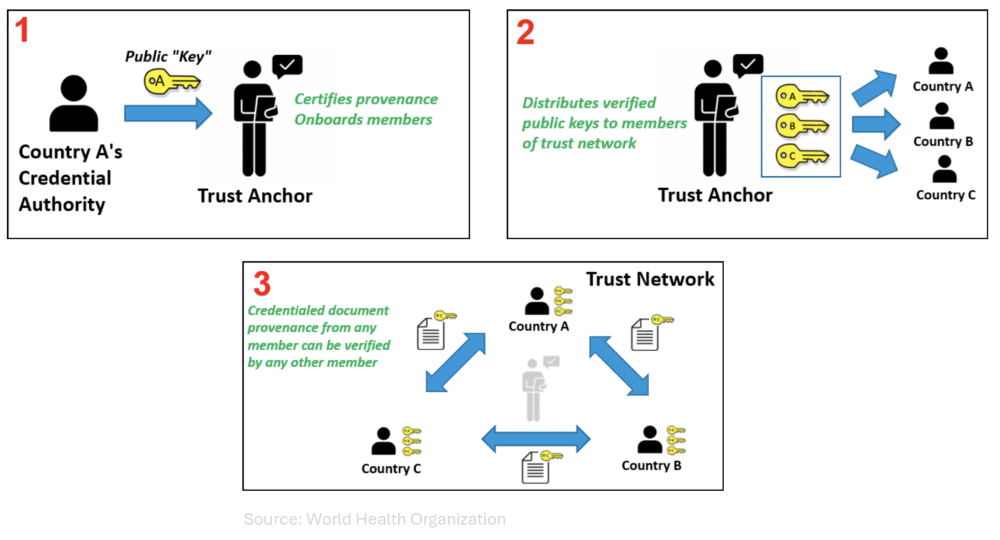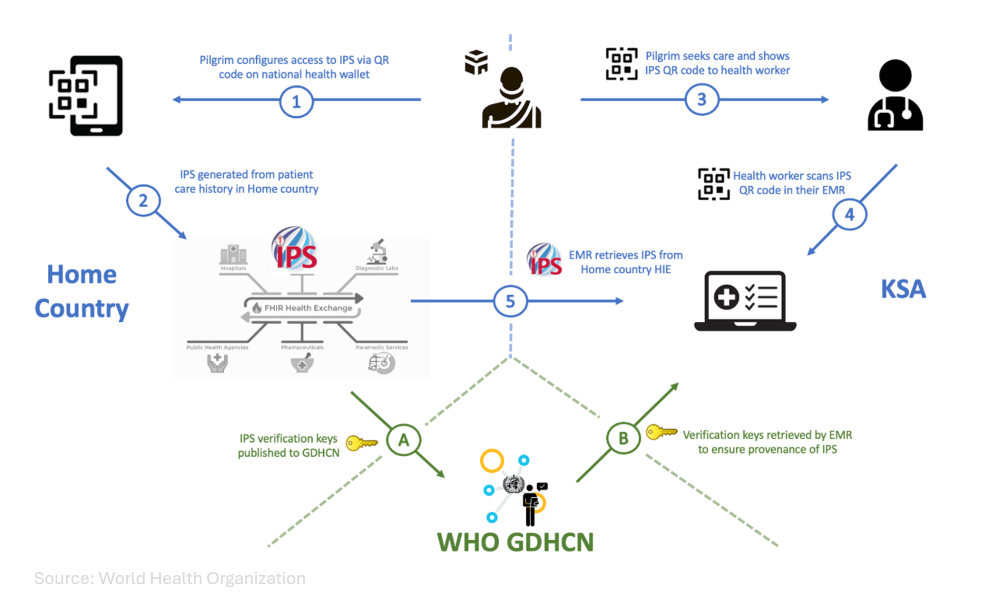
The World Health Organization (WHO) adopts the Interoperability Test Bed (ITB) as its conformance testing solution going forward, with a first use case in support of the 2025 Hajj Pilgrimage.

The World Health Organization (WHO) is the United Nations agency promoting health, and ensuring it is available to everyone, everywhere at the highest possible level. It leads global efforts to expand universal health coverage, direct health emergency responses, and promote healthier lives. The WHO works with 194 Member States across 6 regions and, at a local level at more than 150 locations, by closely collaborating with local authorities, international organisations, foundations, advocates, researchers and health workers.
Focusing on digital services, and in particular the IT systems involved in healthcare provision, is the role of the WHO’s Digital Systems team, which supports the Global Digital Health Certification Network (GDHCN). The GDHCN serves as a building block for digital public health infrastructure, enabling a trust network for partner countries to bilaterally verify the authenticity of digital records and health certificates through a trust architecture, facilitated – but not controlled – by the WHO acting as a “trust anchor”.

The GDHCN is built upon partner countries’ software infrastructure that is in turn based upon common technical and semantic standards to ensure interoperability. To support this interoperability, the WHO leverages community-contributed testing tools, such as the GDHCN Validator, which enables GDHCN community members to test and validate their implementations.
Adoption of the Interoperability Test Bed by the WHO
In the beginning of 2025, and with a goal of further facilitating development while strengthening interoperability, the WHO took the strategic decision to adopt the Interoperability Test Bed (ITB) as its conformance testing solution. This move aims to reuse existing test suites and tools such as the GDHCN Validator, while expanding them based on the ITB’s rich test capabilities. The ITB is seen as a user-friendly means of sharing testing services with partners, that can also be easily adapted to the needs of specific projects, ranging from a centralised service to downloadable self-hosted packages.
“Trust in digital health starts with confidence in its foundations. By adopting the Interoperability Test Bed, we’re helping countries build systems that are secure, connected, and ready for global collaboration—starting with life-saving initiatives like the Hajj Health Card. We’re grateful for our collaboration with the European Commission through the Directorate-General for Informatics (DIGIT), which shows the power of partnership in advancing global digital health.”
— Dr Alain Labrique, Director, Digital Health and Innovation, WHO
The WHO’s strategic vision is to use the ITB going forward for multiple future projects, with the focus currently on establishing a robust testing infrastructure for digital health certification systems and digital health architecture. This includes the active development of testing capabilities for the GDHCN, such as Public Key Infrastructure (PKI) management, verification workflows, and the testing of Verifiable Health Links (VHLs) and QR code verification to ensure document provenance.
First use case in support of the 2025 Hajj Pilgrimage
The first ITB use case at the WHO will be in support of the 2025 Hajj Pilgrimage which will begin in the first week of June. Specifically, this refers to the SMART Verifiable International Patient Summary (IPS) for Pilgrimage, an initiative announced by the WHO and the Kingdom of Saudi Arabia in October 2024. The goal is to expand the GDHCN to cover the Hajj Health Card in support of the roughly 3 million pilgrims who undertake the holy pilgrimage every year.

The role of the ITB will be to test the participating countries’ IT solutions responsible for issuing and verifying the pilgrims’ health certificates. The implementation and rollout is expected to take place in two phases:
- Phase 1, planned for 2025, foresees “sandbox testing” of individual solutions in a standalone manner aiming for full specification coverage. The first 2025 Hajj will be supported by a limited set of core test cases.
- Phase 2, beyond 2025, will expand to peer-to-peer testing in connectathon-style events, integrating the ITB with the IHE Gazelle solution. At this point the sandbox testing will expand to also prepare participants for the peer-to-peer testing events.
The test cases, both in terms of definition and implementation, will in all cases be made publicly available for those interested in the overall data flows. The scenarios for Hajj Health Records as SMART Verifiable IPS are already published online.
Future steps beyond the Hajj Pilgrimage
The Hajj Pilgrimage of 2025 acts as an initial milestone providing valuable experience to the WHO, and a reusable test infrastructure for similar events going forward. Besides expanding the Hajj testing support beyond 2025, initial planning has already started towards providing similar services in different contexts. The next use case already identified is in support of RACSEL, the Latin American and Caribbean digital health network, for the implementation of the Digital Vaccine Certificate (DVC) and wallet. The upcoming milestone in this case will be the next RACSEL Connectathon to be held in October 2025 in El Salvador.
Find out more
The best source for further information on the WHO’s GDHCN is the official WHO website. Details on the Hajj Pilgrimage can be found in the initial announcement, with technical details in the implementation guide. Regarding the Interoperability Test Bed itself, general details on its services and use cases can be found in the Interoperable Europe Portal, with its value proposition being a good starting point for newcomers. To receive updates on Test Bed news and releases remember to subscribe to the Test Bed on the Portal, and to follow Interoperable Europe’s updates on X and LinkedIn.
The Interoperability Test Bed is a service provided by the European Commission’s DIGIT, offering conformance testing and validation solutions in support of IT systems’ cross-border interoperability.
Referenced solution


